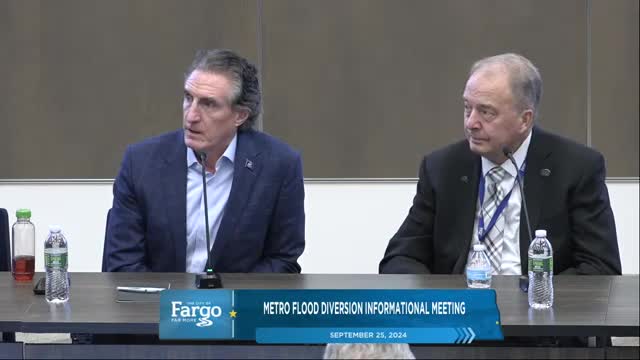Officials warn of potential disaster if flood control fails
September 25, 2024 | Fargo , Cass County, North Dakota
This article was created by AI summarizing key points discussed. AI makes mistakes, so for full details and context, please refer to the video of the full meeting. Please report any errors so we can fix them. Report an error »

In a recent government meeting, officials reflected on the long-lasting impacts of past flooding events in North Dakota, particularly the devastating floods of 1997 that severely affected Grand Forks and Fargo. The discussions highlighted the significant recovery challenges faced by communities, with Grand Forks' K-12 school enrollment not returning to pre-flood levels until two decades later. The city saw a drop in population from over 50,000 to 40,000 following the evacuation during the floods, illustrating the extensive economic disruption caused by such natural disasters.
Officials also noted ongoing recovery efforts in Minot, which is still grappling with the aftermath of the 2011 floods. The meeting underscored the critical need for flood control measures, particularly in light of the current state of hospital capacity, which is reportedly 25% behind in the diversion area. The potential consequences of a major flood event in the region were emphasized, with officials warning that the disruption would far exceed previous calamities.
The conversation shifted to the importance of the ongoing flood diversion project, which is projected to protect over $60 billion in property value. While acknowledging the project's high costs, officials argued that the investment is justified when considering the potential economic benefits. They referenced Winnipeg's experience, where the completion of a diversion project led to a marked increase in economic activity, suggesting that similar outcomes could be expected for the Fargo-Moorhead metro area.
As the meeting concluded, officials reiterated the necessity of focusing on flood management, particularly as much of the current activity is concentrated on the North Dakota side of the river. The discussions reflect a broader commitment to ensuring community resilience against future flooding events.
Officials also noted ongoing recovery efforts in Minot, which is still grappling with the aftermath of the 2011 floods. The meeting underscored the critical need for flood control measures, particularly in light of the current state of hospital capacity, which is reportedly 25% behind in the diversion area. The potential consequences of a major flood event in the region were emphasized, with officials warning that the disruption would far exceed previous calamities.
The conversation shifted to the importance of the ongoing flood diversion project, which is projected to protect over $60 billion in property value. While acknowledging the project's high costs, officials argued that the investment is justified when considering the potential economic benefits. They referenced Winnipeg's experience, where the completion of a diversion project led to a marked increase in economic activity, suggesting that similar outcomes could be expected for the Fargo-Moorhead metro area.
As the meeting concluded, officials reiterated the necessity of focusing on flood management, particularly as much of the current activity is concentrated on the North Dakota side of the river. The discussions reflect a broader commitment to ensuring community resilience against future flooding events.
View full meeting
This article is based on a recent meeting—watch the full video and explore the complete transcript for deeper insights into the discussion.
View full meeting
